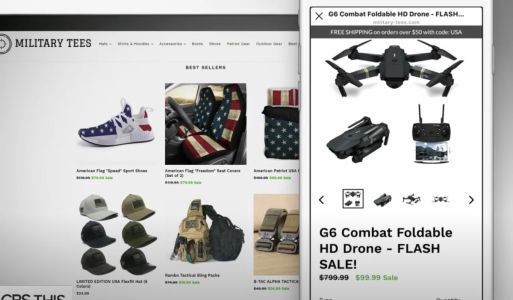10 warning signs that social media ad might be a scam—have you seen these tricks?
By
Veronica E.
- Replies 0
If you’ve spent time scrolling through Facebook or other social media sites, you’ve likely seen your feed filled with tempting ads—from miracle skincare products to can’t-miss tech deals.
But behind many of these ads could be something far less appealing: a scam.
At The GrayVine, we know how important it is to stay safe online, especially as fraudsters become more convincing.
Fake social media ads are one of the fastest-growing online threats in the US.
Here's how to spot the red flags—and protect yourself before clicking “Buy Now.”

If an ad promises a $500 item for $30 or offers a brand-new phone at a steep discount, take a step back.
Scammers rely on unrealistic deals to lure you in.
Tip: Watch for pressure phrases like “limited time offer” or “only a few left”—they’re designed to make you act fast.
Well-known brands rarely offer rock-bottom prices outside of major sales.
Deep discounts on designer items or tech products are a common red flag.
Tip: Compare prices on the brand’s official website or with trusted retailers before making a decision.
Before entering your personal or payment information, take a close look at the site URL.
Secure websites begin with “https”—that “s” stands for secure. Scammers often use “http” or misspelled domain names.
Tip: Instead of clicking the ad, search for the brand directly and shop from its verified website.
Legitimate retailers usually let you browse and learn about a product before asking for payment.
If an ad or site immediately requests credit card information—or redirects you to a third-party payment app—proceed with caution.
Tip: Avoid entering debit card or bank info. Use a credit card for added fraud protection.
Scam accounts often impersonate real businesses.
They may use a brand’s logo but have usernames with extra characters, fake followers, or minimal post activity.
Tip: Check for verified checkmarks and consistent activity. A large following with very few likes or comments is a red flag.
Legitimate businesses welcome feedback.
If an ad or post has comments disabled, it may be hiding complaints or negative reviews.
Tip: If you can’t see what others are saying, it’s smart to walk away.
Scammers use polished images and copied branding to look legitimate.
Just because an ad looks good doesn’t mean it’s real.
Tip: Cross-check the product and brand on their official social media pages or website.
If a product has nothing but glowing praise, be wary.
Many scammers use fake or AI-generated reviews to build trust.
Tip: Look for specific, detailed reviews—and trust your instincts if something feels “off.”
Real brands use hashtags to increase visibility.
Scammers often avoid them to avoid detection.
Tip: Look for the “Sponsored” tag on ads—it’s not a guarantee, but it does show the platform has reviewed the ad placement.
If liking or commenting on an ad leads to a message pressuring you to buy, that’s a major warning sign.
Bots and scammers use high-pressure tactics to rush your decision.
Tip: Legitimate businesses don’t usually cold-message you. If something feels urgent or aggressive, it’s best to ignore it.
If you’ve already clicked or shared payment info:
As social media scams become more sophisticated, staying alert is your best defense.
By learning the warning signs and taking a few extra moments to verify what you see online, you can shop with confidence and help protect yourself—and others—from fraud.
Read next: Warning: These websites could spell trouble for Chrome, Safari, Firefox, and Edge users!

Have you ever come across a questionable ad? Did you almost get caught—or do you have a tip to help others stay safe? Share your experience in the comments below! Stay safe out there—and when in doubt, don’t click.
But behind many of these ads could be something far less appealing: a scam.
At The GrayVine, we know how important it is to stay safe online, especially as fraudsters become more convincing.
Fake social media ads are one of the fastest-growing online threats in the US.
Here's how to spot the red flags—and protect yourself before clicking “Buy Now.”

Online ads may look convincing, but scammers are using social media to trick shoppers. Image Source: YouTube / CBS Mornings.
1. The deal sounds too good to be true
If an ad promises a $500 item for $30 or offers a brand-new phone at a steep discount, take a step back.
Scammers rely on unrealistic deals to lure you in.
Tip: Watch for pressure phrases like “limited time offer” or “only a few left”—they’re designed to make you act fast.
2. The price is unusually low
Well-known brands rarely offer rock-bottom prices outside of major sales.
Deep discounts on designer items or tech products are a common red flag.
Tip: Compare prices on the brand’s official website or with trusted retailers before making a decision.
3. The website address looks off
Before entering your personal or payment information, take a close look at the site URL.
Secure websites begin with “https”—that “s” stands for secure. Scammers often use “http” or misspelled domain names.
Tip: Instead of clicking the ad, search for the brand directly and shop from its verified website.
4. They ask for payment details right away
Legitimate retailers usually let you browse and learn about a product before asking for payment.
If an ad or site immediately requests credit card information—or redirects you to a third-party payment app—proceed with caution.
Tip: Avoid entering debit card or bank info. Use a credit card for added fraud protection.
Also read: Are you a swindler's target? Learn how to outsmart holiday scams online!
5. The social media account looks suspicious
Scam accounts often impersonate real businesses.
They may use a brand’s logo but have usernames with extra characters, fake followers, or minimal post activity.
Tip: Check for verified checkmarks and consistent activity. A large following with very few likes or comments is a red flag.
6. Comments are turned off
Legitimate businesses welcome feedback.
If an ad or post has comments disabled, it may be hiding complaints or negative reviews.
Tip: If you can’t see what others are saying, it’s smart to walk away.
Also read: Are Facebook and Instagram spying on you? Here’s how to stop it
7. The ad looks professional—but something feels wrong
Scammers use polished images and copied branding to look legitimate.
Just because an ad looks good doesn’t mean it’s real.
Tip: Cross-check the product and brand on their official social media pages or website.
8. There are only five-star reviews
If a product has nothing but glowing praise, be wary.
Many scammers use fake or AI-generated reviews to build trust.
Tip: Look for specific, detailed reviews—and trust your instincts if something feels “off.”
Also read: Protect your privacy: 3 hidden iPhone settings tracking you—turn them off now!
9. The post has no hashtags or suspicious formatting
Real brands use hashtags to increase visibility.
Scammers often avoid them to avoid detection.
Tip: Look for the “Sponsored” tag on ads—it’s not a guarantee, but it does show the platform has reviewed the ad placement.
10. You get pressured in direct messages
If liking or commenting on an ad leads to a message pressuring you to buy, that’s a major warning sign.
Bots and scammers use high-pressure tactics to rush your decision.
Tip: Legitimate businesses don’t usually cold-message you. If something feels urgent or aggressive, it’s best to ignore it.
Also read: Delete these 15 risky apps now before it’s too late!
Extra tips for staying safe online
- Use strong, unique passwords across different accounts
- Enable two-factor authentication for extra security
- Report suspicious ads or accounts to the platform
- Talk with friends and family about online safety—especially those less familiar with scams
What to do if you think you’ve been scammed
If you’ve already clicked or shared payment info:
- Contact your credit card provider to report the fraud
- Change your passwords, especially if the scam involved a login
- Report the scam to the Federal Trade Commission (FTC) and the social media platform
- Monitor your accounts for suspicious activity
As social media scams become more sophisticated, staying alert is your best defense.
By learning the warning signs and taking a few extra moments to verify what you see online, you can shop with confidence and help protect yourself—and others—from fraud.
Read next: Warning: These websites could spell trouble for Chrome, Safari, Firefox, and Edge users!
Key Takeaways
- Fake social media ads are becoming increasingly common, with scammers using sophisticated tactics to lure shoppers and steal personal details.
- Major warning signs include offers that seem too good to be true, absurdly low prices, websites without '"https" security, and requests for payment or credit card details before providing adequate information.
- Scam social media accounts may mimic real brands, have comments turned off, display questionable five-star reviews, use few hashtags, or rely on AI-generated interactions to engage users.
- Experts recommend never clicking suspicious links, double-checking brand authenticity by visiting official websites directly, and using credit cards (not debit cards) for online purchases due to better consumer protection.
Have you ever come across a questionable ad? Did you almost get caught—or do you have a tip to help others stay safe? Share your experience in the comments below! Stay safe out there—and when in doubt, don’t click.






